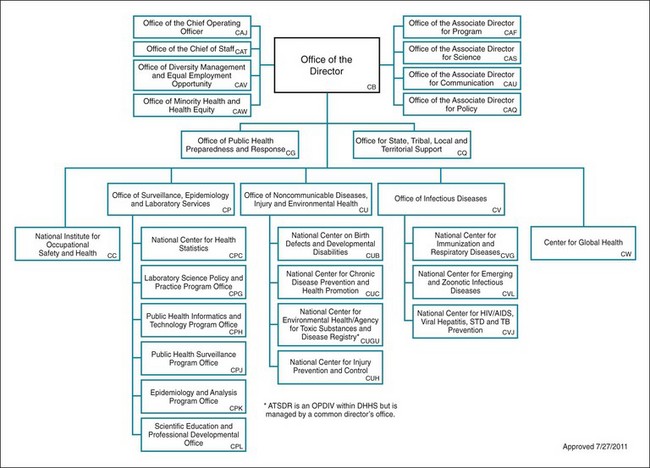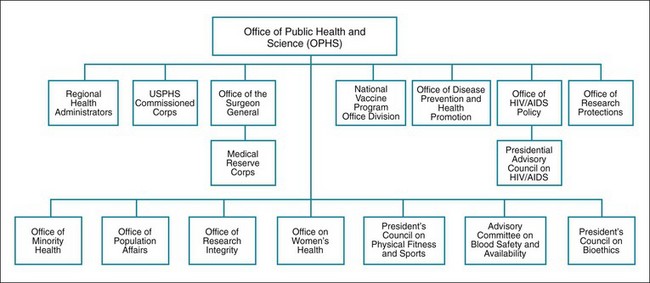25 Public Health System
Structure and Function
The U.S. Institute of Medicine (IOM) describes the challenges inherent in organizing the public health system for the 21st century as follows1:
I Administration of U.s. Public Health
A Responsibilities of the Federal Government
2 Taxation for the General Welfare
The power to “tax for the general welfare” is the constitutional basis for the federal government’s development of most of its public health programs and agencies, including the Centers for Disease Control and Prevention (part of the Department of Health and Human Services) and the Occupational Safety and Health Administration (OSHA, part of the Department of Labor); for research programs, such as those of the National Institutes of Health (NIH); and for the payment for medical care, such as Medicare and Medicaid (see Chapter 29).
5 Coordination of Federal Agencies
In the United States the federal department most concerned with health is the Department of Health and Human Services (DHHS), which has four major operating units, described next2 (Fig. 25-1).
Centers for Medicare and Medicaid Services
The Centers for Medicare and Medicaid Services (CMS) is responsible for administering two major programs of the Social Security Act. Medicare is covered under Title 18 of the Social Security Act and pays for medical care for the elderly population. Medicaid is covered under Title 19 and pays for medical and nursing home care in cooperation with the states (see Chapter 29). CMS duties include setting standards for programs and institutions that provide medical care, developing payment policies, contracting for third-party payers to cover the bills, and monitoring the quality of care provided. CMS also supports graduate medical education, residency, and fellowship programs that provide care for individuals covered by Medicare or Medicaid.
Public Health Service
The U.S. Public Health Service (PHS) comprises the following eight constituent agencies:
1. The Agency for Healthcare Research and Quality (AHRQ) is the main federal agency for research and policy development in the areas of medical care organization, financing, and quality assessment. Since 2000, the agency has placed increasing emphasis on medical care quality.
2. The Agency for Toxic Substances and Disease Registry (ATSDR) provides leadership and direction to programs designed to protect workers and the public from exposure to and adverse health effects of hazardous substances that are kept in storage sites or are released by fire, explosion, or accident.
3. The Centers for Disease Control and Prevention (CDC) has the responsibility for “protecting the public health of the [United States] by providing leadership and direction in the prevention and control of diseases and other preventable conditions and responding to public health emergencies.” The CDC directs and enforces federal quarantine activities; works with states on disease surveillance and control activities; develops programs for prevention and immunization; is involved in research and training; makes recommendations on how to promote occupational health and safety through the National Institute on Occupational Safety and Health (NIOSH); provides consultation to other nations in the control of preventable diseases; and participates with international agencies in the eradication and control of diseases around the world. The CDC has a complex organizational structure (Fig. 25-2).
4. The Food and Drug Administration (FDA) is the primary agency for regulating the safety and effectiveness of drugs for use in humans and animals; vaccines and other biologic products; diagnostic tests; and medical devices, including ionizing and nonionizing radiation–emitting electronic products. The FDA is also responsible for the safety, quality, and labeling of cosmetics, foods, and food additives and colorings.
5. The Health Resources and Services Administration (HRSA) is responsible for developing human resources and methods to improve health care access, equity, and quality, with an emphasis on promoting primary care. HRSA also supports training grants and training programs in preventive medicine and public health.
6. The Indian Health Service promotes the health of and provides medical care for Native Americans and Alaska Natives.
7. The National Institutes of Health (NIH) consists of 27 institutes, which perform intramural (in-house) research on their particular diseases, organ systems, or topics (e.g., National Cancer Institute; National Heart, Lung, and Blood Institute; National Human Genome Research Institute; National Center for Advancing Translational Science). The institutes also review and sponsor extramural research at universities and research organizations through competitive grant programs. Some of the institutes also undertake disease control programs and public and professional education in their area (e.g., National Library of Medicine, National Institute for Neurological Disorders and Stroke).
8. The Substance Abuse and Mental Health Services Administration (SAMHSA) provides national leadership in preventing and treating addiction and other mental disorders, based on up-to-date science and practices, and has four major operating divisions: Center for Mental Health Services, Center for Substance Abuse Prevention, Center for Substance Abuse Treatment, and Center for Behavioral Health Statistics and Quality.

Figure 25-2 U.S. Centers for Disease Control and Prevention (CDC) organizational chart.
STD, Sexually transmitted disease; TB, tuberculosis.
The PHS is not the only important agency in public health. The other major federal organization is the Office of Public Health and Science (OPHS), which leads the Healthy People initiative through its Office of Disease Prevention and Promotion (see Chapter 26) and oversees the U.S. Surgeon General’s office, President’s Council on Bioethics, U.S. Public Health Service Commissioned Corps, and Office of Minority Health (Fig. 25-3).
B Responsibilities of States
In 1988 the IOM stated that “the mission of public health is to ensure conditions in which people can be healthy”, and that the three “core functions of public health agencies at all levels of government are assessment, policy development, and assurance.”3
1. The assessment role requires that “every public health agency regularly and systematically collect, assemble, analyze, and make available information on the health of the community, including statistics on health status, community health needs, and epidemiologic and other studies of health problems.”3
2. The policy development role requires that “every public health agency exercise its responsibility to serve the public interest in the development of comprehensive public health policies by promoting the use of the scientific knowledge base in decision-making about public health,. .. by leading in developing public health policy, and by taking a strategic approach, developed on the basis of a positive appreciation for the democratic political process.”3
3. The assurance role requires that “public health agencies assure their constituents that services necessary to achieve agreed upon goals are provided, either by encouraging action by other entities (private or public sector), by requiring such action through regulation, or by providing services directly.”3
Stay updated, free articles. Join our Telegram channel

Full access? Get Clinical Tree




